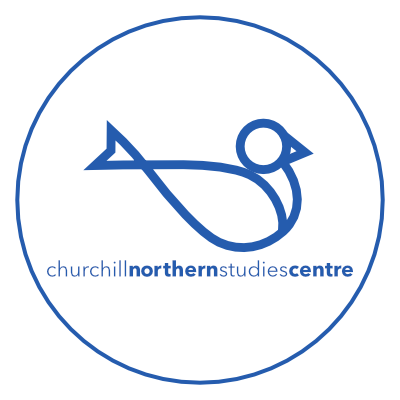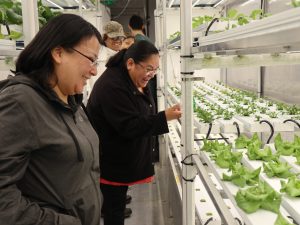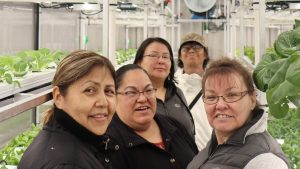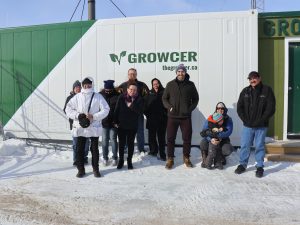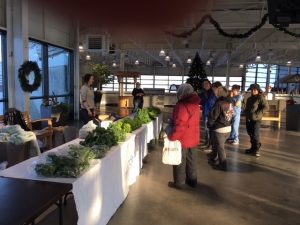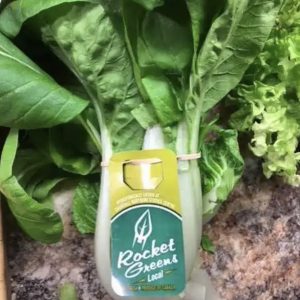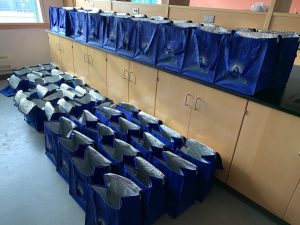Interviewer: Fiona Rettie, Sustainability Tech
Interviewee: Carley Basler, Rocket Greens operator and Sustainability Coordinator
Fostering community connections
The blizzard that hit Churchill on Dec 16, 2021 kept the CNSC staff at home as winds gusted to 90 km/h, creating drifts that made Launch Road impassable. Our sustainability team of Carley and Fiona, and our science technician Dani sat around their kitchen table in town to chat about Rocket Greens as we approached our 4th anniversary. This interview is separated into two parts.
In Part 1, Carley speaks about the beginnings of Rocket Greens, how she pioneered the “LaunchBox” subscription service, and how she has connected with northern Manitobans over the last four years.
1. Beginning the Project
Fiona: So Carley – when you returned to the CNSC (Churchill Northern Studies Centre) in 2017, you came back as the building manager and operator of this brand-new project. What exactly brought you back, and what’s kept you here the last four years?
Carley: Back in 2017, LeeAnn approached me in the airport and said “We have this thing coming. [The Growcer] is in the works now, and we can actually talk about it: it’s a hydroponic shipping container, and we think operating it would be a good fit for you, are you interested in coming back?”
So, I did have an offer from the CNSC – literally a folded piece of paper – in my back pocket the day that I left my previous job. LeeAnn knew that I had an interest in indoor growing, and that’s how I jumped on the project.
As for what’s kept me here? I do love Rocket Greens. Fresh leafy greens, the project itself, and the connections to other places in Northern Manitoba. We’ve built more relationships with people in the community as well, and I really enjoy those parts of the Rocket Greens project.
2. Connecting the North
Fiona: A lot of your time is spent connecting with other northern communities who are interested in having this project. What has that been like?
Carley: I really enjoy talking with other northern communities. I’ve talked to northern and southern communities alike, but I enjoy speaking to Manitoban communities most, lots of connections have been made through the collaborative (Northern Manitoba Food Community and Culture Collaborative, also known as the NMFCCC).
Before the project, my previous experience in Churchill was really kind of removed from town, because we lived out at the cabin year-round.
This outreach piece of the project has definitely made me feel like a part of a broader Northern-Manitoba community. What’s nice is that there are so many people who are interested in being part of projects like Rocket Greens. The Chief from Fox Lake Cree Nation came in to the Studies Centre the other day and I was like, okay, we’ve actually talked before, and more than once! Building these relationships is so cool.
We also hosted a workshop a couple of years ago when NMFCCC offered a planning grant. We decided to spend the money on travel for six communities, and gave them accommodation at the CNSC.
We were joined by Norway House, Pukatawagan, Roseau River, Wasagamack, Garden Hill, and Sandy Bay. There was a consulting company already working with all these communities, so we collaborated with them – they did organization and logistics, and we set things up here at the Centre and paid for train fares.
We would have chats in the morning and then would do activities in the Growcer each day like harvesting, cleaning and transplanting. We’d talk about calendars and planning and marketing – all the pieces that I put together in our first year of the Rocket Greens project.
We also had a cooking class with a Winnipeg Regional Health Authority (WRHA) dietician around the same time. The workshop folks boosted our numbers, and it allowed them to do a little bit of cooking with what we’d grown. Out of those people, I don’t think anybody except Norway House has a Growcer now, but there is still interest from lots of places in similar programs. Fox Lake and York Factory First Nation are looking into hydroponics, too.
3. Our first harvest

First harvest December 22, 2017.
Fiona: Can you tell us about the first-ever harvest and community feast?
Carley: The very first harvest was on December 22, 2017, and the community feast was the same week. Our very first harvest was mostly butterhead lettuce and leaf lettuce. We did have the Rocket Greens logo then – not the final iteration that you see now – but we were able to put the logo on our bags for when we handed them out to everybody, so they knew who we were.

This is the lettuce from the very first harvest! This is how we tagged them so that people would know it wasn’t donated by Danica’s village like so much else – that we grew it ourselves at the Studies Centr
It was great because the Blue Bombers, Danica’s Village, Christmas Cheer and other local organizations were there – so many people were giving away food at the community Christmas feast in 2017 – the atmosphere was pretty special.
Because of this we were a little bit lost in the shuffle, but at least we had our own tags that were recognizable. I actually went around to different tables, dropped off our lettuce to them, and I told them: we grew this at the CNSC!
4. LaunchBox subscription program
Fiona: When and how did the LaunchBoxes get started?
Carley: The harvest after the community feast was the next round of veggies we had. Nobody really knew back then that we had to pick a certain number of greens each week, we were just learning as we went so, that week we brought about 400 pieces to town for a market at the complex overpass. People were coming through the complex and going “Oh my god, it smells so good!” It was very exciting, really cool. We sold almost everything off the table, and people were coming back for more.
“People were coming through the complex and going, ‘Oh my god, it smells so good!’ It was very exciting, really cool. We sold almost everything off the table, and people were coming back for more.”
We sold our greens for the same price that the LaunchBoxes are now: three pieces for 10 bucks, six pieces for 20 bucks. That day it was a” pick what you want” sort of thing – I just wanted people to see it and smell it.
While we were chatting with everybody, I was collecting email addresses from them. Before the next harvest, I emailed everybody on that list and asked if they wanted to sign up. The following week we had 10 subscribers, and the next week we had 20. So really, we’ve had between 20 and 60 subscribers since the second week, before we even had proper LaunchBoxes for distribution.
Back then it was all Rubbermaid bins and plastic Northern Store shopping bags. There was a lot of handling and lots of leaves on the floor afterwards, but people were still happy.
I mean, most of those people have been here since day one. If you had asked me in 2019, there would have been about 15 or 20 families on the LaunchBox list that had been with us since the very start. Through a year and a half without rail, the port closing, and the pandemic, a lot of things have changed here in Churchill… but these people are still picking up their greens every Wednesday.
“Through a year and a half without rail, the port closing, and the pandemic, a lot of things have changed here in Churchill… but these people are still picking up their greens every Wednesday.”
5. Creating the LaunchBox
Fiona: What was your thinking behind the LaunchBoxes?
Carley: Especially with the project being launched in December when the population in Churchill is so low, I felt like the only way to make sure that we could move the produce was to find a good group of people who wanted this, and were all in.
The ones who definitely bought three or definitely bought six pieces of produce already, I wrote down, along with anyone who wanted to support community projects.
When I really started thinking about the math of it, I knew there was way too much stuff to put out in the store. The grocery stores are not going to sell 100 bundles of lettuce each week, you know?
I had heard that someone in Alaska was doing something similar to the LaunchBox, where people were paying a membership and then coming by each week and picking what they wanted. So we just sort of went from there.
Moving produce year-round requires having a good foundation of people.
